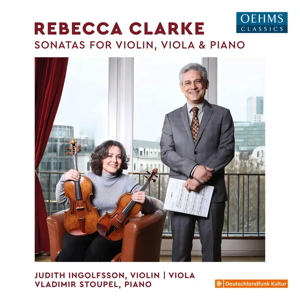
Rebecca Clarke (1886-1979)
Viola Sonata (1919)
Violin Sonata in D major (1908)
Violin Sonata (Sonata Movement) in G major (1907)
Judith Ingolfsson (viola, violin), Vladimir Stoupel (piano)
rec. 2023, Haus des Rundfunks, Berlin, Germany
Oehms Classics OC1731 [61]
Many recordings of Rebecca Clarke’s Viola Sonata are available, and Dutton has explored the early Violin Sonatas but I am not aware that a single artist has recorded them in the way the intrepid Judith Ingolfsson has done here, as both violinist and violist. The gains in a single perspective on the string sonatas, though, have to be balanced against excellence in performance as it is by no means the case that violinists such as Ingolfsson inevitably also excel as violists.
This matters as the major work is clearly the Viola Sonata. Ingolfsson and Vladimir Stoupel take a somewhat measured view of the sonata as a whole – certainly nothing outlandish, though – which means that the outer movements are a touch, but only a touch, lacking in vitality. She retains fine tone, though there’s not the full richness in the lower registers that specialist violists such as Martin Outram (Nimbus) or Paul Coletti (Helios) find. In general, Ingolfsson’s tone remains somewhat violinistic. Tempo-wise she reminds me of Barbara Westphal with Jeffrey Swann on Bridge though I’d make the observation that Westphal finds a rather better tempo for the first movement ensuring that it flows more logically. The many folkloric incidents emerge attractively and the long finale’s introspective impressionistic elements similarly but for a Shock of the New performance you’ll need Matthew Jones and Michael Hampton on Naxos or Tabea Zimmermann and Kirill Gerstein on MYR004, who are not only outstanding instrumentalists – Zimmermann, of course, is one of the premier violists of her generation – but zestful, incisive interpreters with myriad tonal subtleties at their command.
The Violin works are much more conventional examples of the Stanford-trained Clarke’s work, composed before she switched permanently to playing the larger instrument. The Sonata in D major is decidedly Brahmsian in affiliation, but the piano writing is deft, and the pizzicato passages well judged. The central movement is the most impressive, a ballad-like piano introduction wistfully taken up by the violin, Anglo-German features strongly audible. It was the rising scale in this movement that caused Stanford abruptly to leave the room where Clarke was playing it for him; he went straight to the Royal College of Music’s violin professor, Enrique Fernandez Arbos, to show him the passage in question, so impressive did he find it. The finale is a Scherzando, though it’s the least interesting movement, and shows touches of Dvořák, no bad thing, of course. Finely though it’s played here, Lorraine McAslan, with Ian Jones on Dutton, mitigate the finale’s sectionality by driving through it at an appreciably tighter tempo.
The other fiddle sonata is that in G major, though in the Dutton recording it is also referred to as a sonata movement, around 11 minutes long. It opens with Bachian flourishes, but the piano then modifies this via light Anglicisms to attractive long-breathed lyricism.
The Oehms team has been excellently recorded in Berlin’s Haus des Rundfunks and violinist-violist herself wrote pertinent notes. This is a commendable release. If I prefer other recordings of the Viola Sonata and McAslan offers similarly stiff competition in the Violin works, this disc allows the listener an opportunity to examine Clarke’s development from her absorption of Brahms to her increasing awareness of contemporary modernist currents.
Jonathan Woolf
Help us financially by purchasing from



















